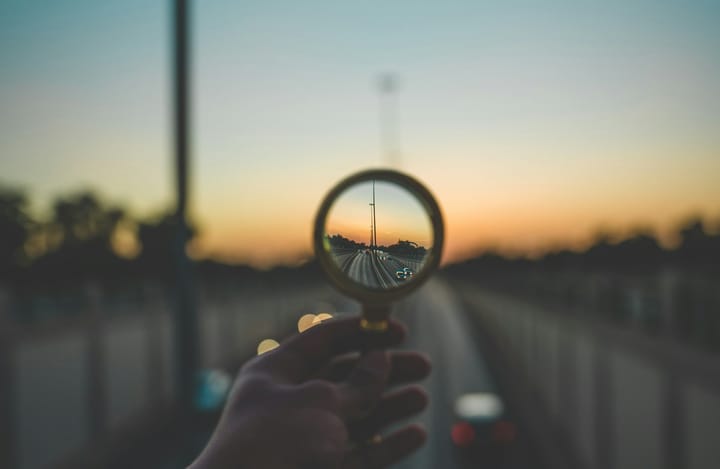Starter Pack: Digital Minimalism in 2025
A practical beginner's guide to reclaiming your attention and peace of mind in our hyper-connected world. Start small, see big changes.
Feeling like your phone owns you instead of the other way around?
You're not alone. We've created a world where checking your phone 150+ times a day feels normal, where every surface has a screen, and where being "disconnected" for an hour triggers genuine anxiety.
But here's what the digital detox influencers won't tell you: You don't need to become a digital hermit to find peace. You just need to be more intentional about technology instead of letting it run your life on autopilot.
I spent two years experimenting with different levels of digital minimalism, from extreme phone fasts to subtle notification tweaks. Some experiments were life-changing, others were unsustainable disasters.
This starter pack contains only the changes that stuck - the ones that improved my mental health and productivity without making me feel like I was living in 1995.
Battle-tested by someone who went from phone zombie to intentional tech user while still enjoying the genuine benefits of our connected world.
Why Digital Minimalism Matters More Than Ever
Attention is the new currency. Every app is designed by teams of psychologists to capture and monetize your focus.
Constant connectivity creates chronic stress. Your nervous system wasn't designed for 24/7 stimulation and notifications.
Digital overload kills deep thinking. Surface-level information consumption replaces meaningful contemplation and creativity.
Social media amplifies comparison and anxiety. Curated highlight reels make everyone else's life look better than yours.
Information overload leads to decision paralysis. Too many choices and inputs make it harder to act on anything.
But technology isn't the enemy - mindless consumption is.
📱 Phase 1: Smartphone Liberation (Week 1-2)
Start With Your Lock Screen
The change: Remove all notifications except calls and texts
Why it works: Eliminates the dopamine slot machine of constant app alerts
How to do it:
- Go to Settings > Notifications
- Turn off notifications for everything except Phone and Messages
- Remove all badge app icons (those red notification dots)
- Turn off lock screen previews for remaining notifications
Expected result: Your phone stops demanding constant attention
Create Phone-Free Zones
The change: Designate specific areas where phones don't belong
Why it works: Physical boundaries create mental boundaries
Recommended zones:
- Bedroom: Charge phone outside bedroom, use analog alarm clock
- Dining area: Meals without screens improve digestion and relationships
- Bathroom: Resist the urge to scroll during private moments
- First hour of morning: Start day with intention, not reaction
Pro tip: Tell family/roommates about these zones so they can support your boundaries
Replace Phone Habits with Analog Alternatives
Instead of phone alarm: Analog alarm clock (prevents bedtime scrolling)
Instead of phone camera: Carry small digital camera for intentional photo-taking
Instead of phone maps: Print directions or use car GPS for planned trips
Instead of phone entertainment: Carry a book, notebook, or just practice observing
📺 Phase 2: Information Diet (Week 3-4)
Curate Your Information Sources
The problem: Information overconsumption leads to anxiety and inaction
The solution: Deliberately choose what deserves your mental energy
News consumption rules:
- Choose 1-2 trusted sources instead of scrolling multiple feeds
- Set specific times for news consumption (morning coffee, not all day)
- Focus on local news where you can actually take action
- Skip outrage content that makes you angry but powerless
Social media audit:
- Unfollow accounts that consistently make you feel worse
- Mute keywords related to topics that trigger anxiety
- Use "See First" feature for accounts that genuinely add value
- Set time limits using built-in screen time controls
Practice Information Fasting
Weekly digital sabbath: 24 hours completely offline (Friday evening to Saturday evening)
Daily news fast: Skip news consumption one day per week
Social media breaks: Delete apps for predetermined periods (start with 3 days)
Email batching: Check email 2-3 times daily instead of constantly
What you'll notice: Increased calm, better focus, more present-moment awareness
💻 Phase 3: Workspace Optimization (Week 5-6)
Single-Tasking Setup
The change: Configure devices to support focused work instead of distraction
Why it matters: Multitasking is a myth that reduces productivity by up to 40%
Computer setup:
- Use one browser window with minimal tabs
- Turn off all non-essential notifications during work hours
- Use full-screen mode for focused tasks
- Keep desktop clean with only current project files visible
- Use website blockers during deep work periods
Physical workspace:
- Remove screens except what you're actively using
- Position phone out of reach and sight
- Use analog tools (pen, paper, sticky notes) for planning and notes
Create Digital Boundaries
Work vs. personal device separation:
- Separate user accounts on shared devices
- Different browsers for work and personal use
- Specific apps only on specific devices
- Work email only accessible during work hours
Time-based boundaries:
- No screens 1 hour before bed (blue light affects sleep)
- No work email outside office hours
- Technology-free meals with family or friends
- Morning routine without immediate digital input
🧠 Phase 4: Attention Training (Week 7-8)
Practice Boredom Tolerance
The skill: Learning to be unstimulated without immediately reaching for entertainment
Why it's important: Boredom is when creativity and deep thinking happen
Exercises:
- Wait in line without looking at your phone
- Take walks without podcasts or music
- Sit quietly for 5 minutes daily without any input
- Eat meals focusing only on the food and your thoughts
What happens: Your brain learns to generate interesting thoughts instead of consuming them
Develop Sustained Attention
Deep reading practice:
- Read physical books for at least 30 minutes daily
- Take notes by hand while reading
- Discuss what you read with others or journal about it
- Choose challenging material that requires sustained focus
Single-tasking challenges:
- Do one thing at a time for entire activities (cooking, cleaning, walking)
- Listen fully in conversations without planning your response
- Work on projects for 25-50 minute focused blocks
- Practice mindful observation of your surroundings
🔄 Phase 5: Sustainable Integration (Week 9-12)
Design Your Ideal Technology Relationship
Questions to ask yourself:
- What technology genuinely improves my life? (keep this)
- What technology is pure entertainment? (limit this)
- What technology creates anxiety or compulsion? (minimize this)
- What technology helps me connect with people I care about? (optimize this)
Create your personal technology charter:
- Define your values around technology use
- Establish specific rules that align with those values
- Identify triggers that lead to mindless consumption
- Plan responses to those triggers
- Review and adjust monthly
Build Positive Technology Habits
Instead of mindless scrolling:
- Use apps intentionally with specific purposes and time limits
- Schedule social media like you would any other activity
- Create content instead of just consuming
- Connect personally rather than just reacting to posts
Technology for growth:
- Learning apps for skills you want to develop
- Creativity tools for expressing yourself
- Connection platforms for meaningful relationships
- Productivity systems that genuinely save time
🚫 Common Digital Minimalism Mistakes
Going too extreme too fast
Radical changes often lead to burnout and abandonment of the practice
Making it about the technology
It's about your relationship with technology, not the technology itself
Ignoring social consequences
Consider how your changes affect communication with family and friends
Perfectionism around rules
Flexibility and adaptation are more sustainable than rigid rules
Focusing only on reduction
Also consider what positive technologies you want to add or optimize
📊 Measuring Progress
Weekly Check-ins
Questions to ask yourself:
- How often did I reach for my phone automatically?
- Did I feel more or less anxious this week?
- Was I more present in conversations and activities?
- Did I have any moments of boredom that led to interesting thoughts?
- What technology use am I proud of? What would I change?
Monthly Reviews
Track these metrics:
- Screen time totals (most phones provide this data)
- Quality of sleep (often improves with less evening screen time)
- Number of books read or deep focus sessions completed
- Frequency of in-person social interactions
- Overall life satisfaction and stress levels
🎯 Customizing Your Approach
For Students
- Study apps only during study hours
- Social media time limits during school terms
- Phone-free study spaces for better concentration
- Digital note-taking balance with handwritten notes
For Parents
- Model healthy tech use for children
- Family device-free times during meals and before bed
- Separate work and personal technology boundaries
- Tech education rather than just restriction for kids
For Remote Workers
- Dedicated work devices separate from personal entertainment
- Communication boundaries outside work hours
- Background app blockers during focused work time
- Physical separation between work and relaxation spaces
For Social Media Users
- Content creator mode vs. consumer mode
- Time-limited browsing with specific purposes
- Curated feeds that inspire rather than trigger comparison
- Real-world social activities to balance online connections
The Long-Term Digital Minimalism Vision
Year 1: Breaking automatic technology habits and establishing boundaries
Year 2: Technology serves your goals rather than driving your behavior
Year 3: Natural balance between digital and analog activities
Year 5: Modeling healthy technology relationships for others
The ultimate goal: Technology becomes a tool you pick up intentionally rather than a compulsion that controls your attention.
Mental health benefits: Reduced anxiety, improved focus, better sleep, more meaningful relationships, increased creativity and original thinking.
Your 30-Day Quick Start Plan
Week 1: Phone Boundaries
- Remove non-essential notifications
- Create phone-free bedroom and dining areas
- Practice waiting without immediately reaching for phone
Week 2: Information Diet
- Choose 1-2 news sources, eliminate news grazing
- Unfollow social media accounts that create negative feelings
- Try one 24-hour digital sabbath
Week 3: Workspace Focus
- Set up single-tasking computer environment
- Establish work/personal technology boundaries
- Practice 25-minute focused work blocks
Week 4: Attention Training
- Daily boredom tolerance practice
- 30 minutes daily deep reading
- Mindful technology use with specific intentions
After 30 days: Evaluate what's working and design your personal long-term approach
Ready to reclaim your attention? Start with removing all non-essential phone notifications today. Get in touch with your biggest digital minimalism challenge - I love helping people find their ideal technology balance.
Want more intentional living strategies? Check out our guide to life systems that save time or explore stress management guide for managing overwhelm.


